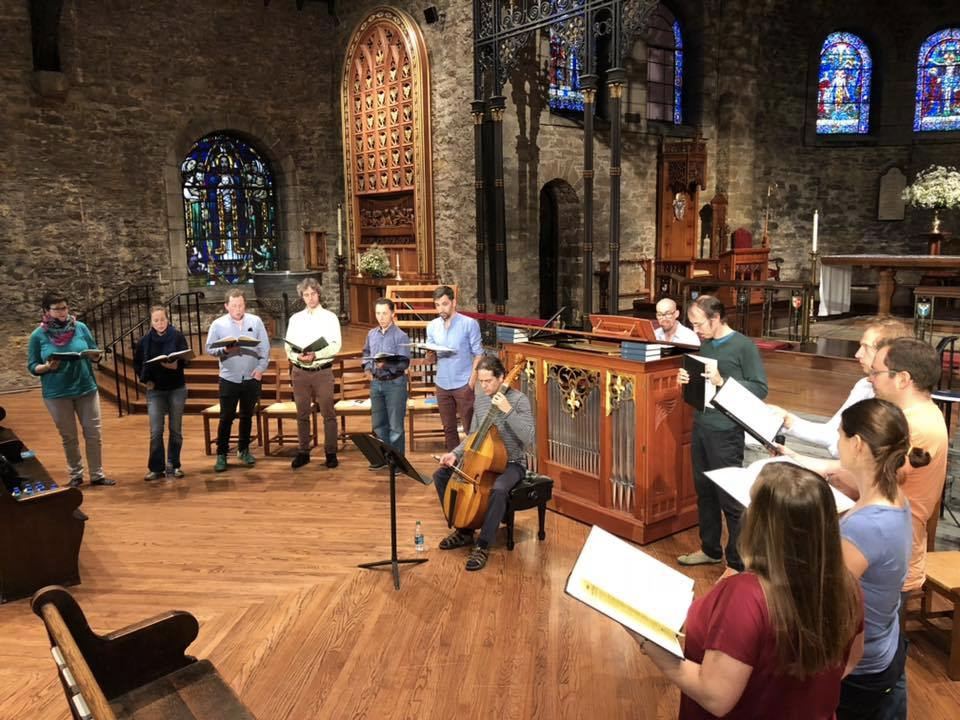by Daniel Hathaway

ClevelandClassical.com’s Nicholas Jones wrote that on October 31, 2014, Vox Luminis “presented a beautifully crafted program that was at once passionate and serene.” This writer reported that the choir’s April 26, 2017 concert was “flawlessly sung,” “made dramatic use of the cathedral space,” and featured “meticulous tuning and vocal blend” in a program of “sober but exquisitely beautiful music.”
Those earlier programs featured laments (Domenico Scarlatti’s 10-voice Stabat Mater) and funeral music (including Purcell’s musical obsequies for Queen Mary). Sensing that the repertoire might be perceived as a bit dour, Meunier said to the audience in 2017, “I have to confess: we do have happier programs!”
The Belgians will prove that on Wednesday with their concert of five Motets by Johann Sebastian Bach, part of a tour which will include the ensemble’s first Bach performances in the United States (above, rehearsing in Kansas City).
Although two of the works can be associated with funeral services (Der Geist hilft for that of Johann Heinrich Ernesti in 1729, and Jesu, meine Freude perhaps for the wife of Leipzig’s postmaster in 1723), the general mood will be festive and upbeat, as the composer’s energetic approach to counterpoint usually guarantees.
What is a Motet, anyway? For Bach, it was a conservative compositional form that harked back to the Renaissance — in distinction to the Cantata, which reflected the new, theatrical forms of expression invented in the Baroque period. Both genres had a place in Sunday services in Leipzig, which began with a Motet and featured a Cantata that sometimes bracketed the sermon for the day.
Vox Luminis’ program will comprise four Motets for double choir (two choirs of four voices each), beginning with Singet dem Herrn ein neues Lied (“Sing to the Lord a new song”) from 1727. Der Geist hilft unser Schwachheit auf (“The Spirit helps us in our weakness”), was written in 1729 for the burial service of the Rector of the Thomaskirche. Komm, Jesu, Komm (“Come, Jesus, come”) dates from 1731-1732.
The fourth double-choir motet, Ich lasse dich nicht (“I will not let you go until you bless me”), was originally thought to be the work of Bach’s older cousin, Johann Christoph Bach, but has recently been reappraised as an early work by Johann Sebastian himself.
The final Motet on the program follows a different format. Written for four-part choir, Jesu meine Freude (“Jesus, my joy”) intersperses stanzas of the chorale of the same name with words from the Epistle to the Romans set by Bach in various ways.
Thanks to the resources of the Internet and the clever use of media by Vox Luminis, you can preview their performance of Ich lasse dich nicht through a YouTube video. (Note: Meunier and his colleagues remain convinced it’s by Johann Christoph!) You can also view a 7-minute trailer about the ensemble’s complete recording of motets by earlier members of the Bach dynasty.
It’s also possible to follow the progress of Vox Luminis’ current United States tour through the running commentary on their website.
Tickets to the October 24th concert at the Cleveland Museum of Art can be ordered online.
Published on ClevelandClassical.com October 23, 2018.
Click here for a printable copy of this article



